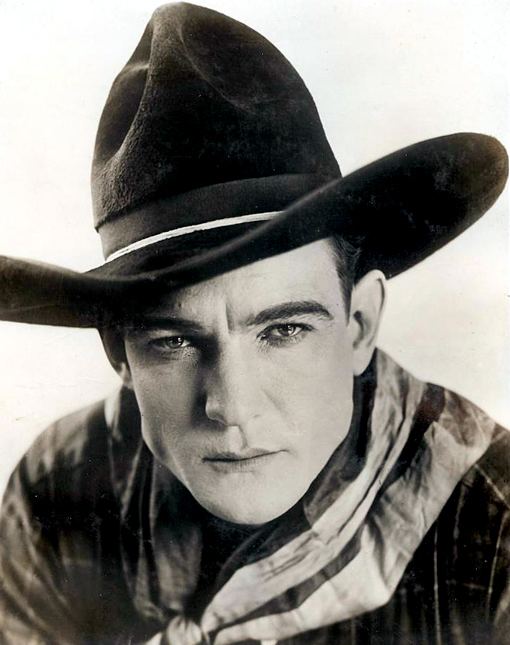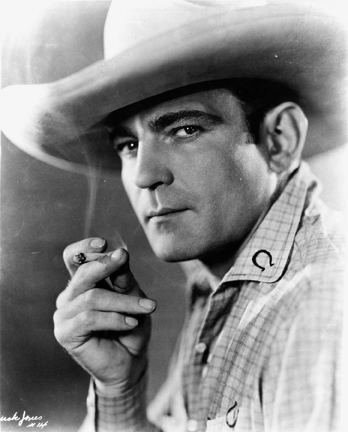Cause of death fire burns Role Movie star Occupation Actor Parents Eva R. McCammon | Years active 1913–1942 Children Maxine Jones Name Buck Jones | |
 | ||
Full Name Charles Frederick Gebhart Died November 30, 1942, Boston, Massachusetts, United States Spouse Odelle Osborne (m. 1915–1942) Movies The Red Rider, The Range Feud, Dawn on the Great Divide, Rough Riders: Below the, Forbidden Trails Similar People Ray Taylor, Noah Beery - Jr, William S Hart, James W Horne, Muriel Evans | ||
Western legends buck jones movie posters
Buck Jones (December 12, 1891 – November 30, 1942) was an American motion picture star of the 1920s, 1930s, and 1940s, known for his work starring in many popular western movies. In his early film appearances, he was billed as Charles Jones.
Contents
- Western legends buck jones movie posters
- Buck jones top 30 highest rated movies
- Early life military service
- Cowboy stuntman beginning of film career
- Stardom
- Radio
- Merchandising
- Death
- Family
- Partial filmography
- References

Buck jones top 30 highest rated movies
Early life, military service

Charles Frederick Gebhart was born on the outskirts of Vincennes, Indiana, on December 12, 1891 (some sources indicate December 4, 1889, but Jones' marriage license and his military records confirm the 1891 date.) In 1907 Jones joined the United States Army a month after his 16th birthday: his mother had signed a consent form that gave his age as 18. He was assigned to Troop G, 6th Cavalry Regiment, and was deployed to the Philippines in October 1907, where he served in combat and was wounded during the Moro Rebellion. Upon his return to the US in December 1909, he was honorably discharged at Fort McDowell, California.

Jones had an affection for race cars and the racing industry, and became close friends with early race-car driver Harry Stillman. Through his association with Stillman he began working extensively as a test driver for the Marmon Motor Car Company. Yet by October 1910 he had re-enlisted in the United States Army. Because he wanted to learn to fly, he requested a transfer to the Aeronautical Division, U.S. Signal Corps in 1913, without knowing that only an officer could become a pilot. He received his second honorable discharge from the Army in October 1913.
Cowboy, stuntman, beginning of film career

Following his military service he began working as a cowboy on the 101 Ranch near Bliss, Oklahoma. While attending equestrian shows he met Odille "Dell" Osborne, who rode horses professionally. The two became involved and married in 1915. Both had very little money, so the producers of a Wild West Show they were working on at the time offered to allow them to marry in an actual show performance, in public, which they accepted.
While in Los Angeles, and with his wife pregnant, Jones decided to leave the cowboy life behind and get a job in the film industry. He was hired by Universal Pictures for $5 per day as a bit player and stuntman. He later worked for Canyon Pictures, then Fox Film Corporation, eventually earning $40 per week as a stuntman. With Fox his salary increased to $150 per week, and company owner William Fox decided to use him as a backup to Tom Mix. This led to his first starring role, The Last Straw, released in 1920.
Stardom
In 1925 Jones made three films with a very young Carole Lombard. He had more than 160 film credits to his name by this time, and he had joined Hoot Gibson, Tom Mix and Ken Maynard as the top cowboy actors of the day. By 1928 he formed his own production company, but his independently produced film The Big Hop (a non-Western) failed. He then organized a touring Wild West show, with himself as a featured attraction, but this expensive venture also failed due to the faltering economy of late 1929.
With the new talking pictures replacing silent films as a national pastime, outdoor Westerns fell out of favor briefly. The major studios weren't interested in hiring Buck Jones. He signed with Columbia Pictures, then just a lowly "B" picture studio, starring in Westerns for $300 a week, a fraction of his top salary in the silent-film days. His voice--a rugged baritone--recorded well and the films were very successful, re-establishing him as a major movie name. During the 1930s he starred in Western features and serials for Columbia and Universal Pictures.
His star waned in the late 1930s when singing cowboys became the rage and Jones, then in his late 40s, was uncomfortably cast in conventional leading-man roles. He rejoined Columbia in the fall of 1940, starring in the serial White Eagle (an expansion of his 1932 feature of the same name). The new serial was a hit, and Jones was again re-established. His final series of Western features, co-produced by Jones and his friend Scott R. Dunlap of Monogram Pictures, featured The Rough Riders trio: Buck Jones, Tim McCoy and Raymond Hatton.
In 1997 a Golden Palm Star on the Palm Springs, California, Walk of Stars was dedicated to him.
In 1960, Jones was honored with a star on the Hollywood Walk of Fame for his contributions to the motion picture industry. The star is located at 6834 Hollywood Blvd.
Radio
In 1937 Jones starred in Hoofbeats, a 15-minute radio program syndicated via electrical transcription. The program was produced in the studios of Recordings, Inc., with Grape Nuts Flakes as sponsor.
Merchandising
Buck Jones lent his name and likeness to various product endorsements, including Post Grape-Nuts Flakes (his radio sponsor) and Daisy Outdoor Products. His licensing also extended to the Big Little Book series, for example:
Jones was also a consultant for Daisy, which issued a Daisy "Buck Jones" model pump-action air rifle. Incorporating a compass and a "sundial" into the stock, it was one of Daisy's top-end air rifles, and sold well for several years. This led to some confusion decades later with the release of the well-known holiday film A Christmas Story, based on author Jean Shepherd's erroneous recollection that the Daisy Red Ryder BB Gun had a compass and sundial in the stock. The latter gun never did have these at any time during its production, save the two specially made examples for the film.
Death
Buck Jones was one of the 492 victims of the Cocoanut Grove fire in Boston, Massachusetts on November 28, 1942. He died two days later on November 30, at 50 years of age.
Family
Buck Jones's daughter, Maxine Jones (born 1918) was married to Noah Beery, Jr. from 1940 to 1966.
